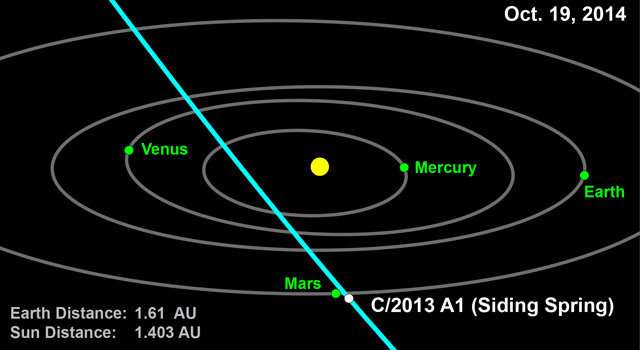NASA’s Near-Earth Object Office says that new observations of comet C/2013 A1 (Siding Spring) have allowed further refinements of the comet’s orbit, helping to determine the chances it could hit Mars in October of 2014. Shortly after its discovery in December 2012, astronomers thought there was an outside chance that a newly discovered comet might be on a collision course with Mars.
While the latest orbital plot places the comet’s closest approach to Mars slightly closer than previous estimates, the new data now significantly reduces the probability the comet will impact the Red Planet, JPL said, from about 1 in 8,000 to about 1 in 120,000.
The closest approach is now estimated at about 68,000 miles (110,000 kilometers). The most previous estimates had it whizzing by at 186,000 miles (300,000 kilometers).
The latest estimated time for close approach to Mars is about 11:51 a.m. PDT (18:51 UTC) on Oct. 19, 2014. At the time of closest approach, the comet will be on the sunward side of the planet.
The comet was discovered in the beginning of 2013 by comet-hunter Robert McNaught at the Siding Spring Observatory in New South Wales, Australia. When the discovery was initially made, astronomers at the Catalina Sky Survey in Arizona looked back over their observations to find “prerecovery” images of the comet dating back to Dec. 8, 2012. These observations placed the orbital trajectory of comet C/2013 A1 right through Mars orbit on Oct. 19, 2014.
JPL says future observations of the comet are expected to refine the orbit further. The most up-to-date close-approach data can be found at JPL’s Small Body Database.
Source: JPL


That means the atmospheres of the two bodies should interact which will provide some unique opportunities for science. It will also be quite a show for the landers and orbiters. This will also be an amazing sight for Earth based astronomers as we watch these two objects close in on each other in the night sky. This will sure beat a run of the mill conjunction as the two objects will be converging in reality rather than apparently.
It does not look that the tail is hitting Mars.
68,000 miles (110,000 kilometers) is actually prettay close… I wonder if that will be close enough to cause the comet to calve or fracture? The offspring wandering off in new orbits… The ‘after’ images from HiRise should be interesting! Got new craters?
At 110,000 Km, the comet will not come within the Roche Limit for Mars. From Wikipedia the Roche Limit is: “the distance within which a celestial body, held together only by its own gravity, will disintegrate due to a second celestial body’s forces exceeding the first body’s gravitational self-attraction.
Not sure how high above Mars it’s Roche Limit is, but for the Earth, it’s said to be about 20,000 Km above the surface. Mars will be considerably less.
Jupiter’s Roche limit is about 242,000 Km. In 1992, Shoemaker-Levy 9 broke up as
it passed within Jupiter’s Roche limit. The odds of C/2013 A1 coming with Mars’ Roche limit seem pretty small.
Consider.. this is comet C/2013 A1’s first passage round Sol. Anything is possible, including massive trajectory changing out-gassing and/or coma ejections prior to passing Mars? Only time’ll tell!
Yes, of course… more food for thought eh?
Here’s another thought…
If the comet DID come within the Roche Limit of Mars and did break up; then the broken fragments of the comet would be flung into new orbits around the Sun. The speed of the comet (estimated to be 56 Km/S upon passing Mars) is VERY far past the escape velocity of Mars (which is about 5 Km/S). The fragments would not enter a suicidal Mars orbit in a “string of pearls” as did Shoemaker–Levy 9’s fragments when it passed through Jupiter’s Roche Limit.
Jupiter’s escape velocity is about 59 Km/S (not sure of what Shoemaker–Levy 9’s passing velocity upon Jupiter was, but obviously it was slow enough to be captured by Jupiters gravity after transiting Jupiter’s Roche Limit). Shoemaker–Levy 9’s initial pass of Jupiter entering it’s Roche Limit (and in this case entering orbit around Jupiter) was thought to occur 20 to 30 years before the impacts.
If there were any new craters on Mars as a result of the comet passing through Mars Roche Limit, they might occur years later as Mars encountered fragments orbiting the sun some orbits later. Of course in this scenario, Earth would probably be just as likely to be hit by the debris. All of this is of course most unlikely even if the comet did break up.
I don’t mean to rip apart your post…. I’m no expert and You gave me food for thought as have a number of your past posts.
Heck… lets have a direct impact for a real show!
Peace!
Just note that “escape velocity” only has meaning when you specify an altitude. 5 km/s for Mars is at its surface. It is much less if you’re passing even 10,000 km away. Also, the speed of the comet is reported as if Mars wasn’t there. Once it swings by Mars, if it comes close, it accelerates relative to Mars, then decelerates. That’s why it is very hard to get “gravity captured”.
Well said Sonny. …take care, ….PEACE!
Hmm. since a comet is mostly water , we might witness the creation of short-lived “Great lakes of Mars”.
Damn, that’s a real pity that the comet is going to miss. It would have been an incredible opportunity to see the impact and aftermath effects of a large planetary impact event on a rocky planet, especially with the instruments that we have in place. Drat the luck…
So there’s still a chance!
If closest approach is on the sunward side of Mars, and (per the JPL graphic) the comet is crossing Mars’ orbital path directly in front of the planet, then it follows that Mars will move directly through the comet’s tail very quickly after the encounter. Is this correct?